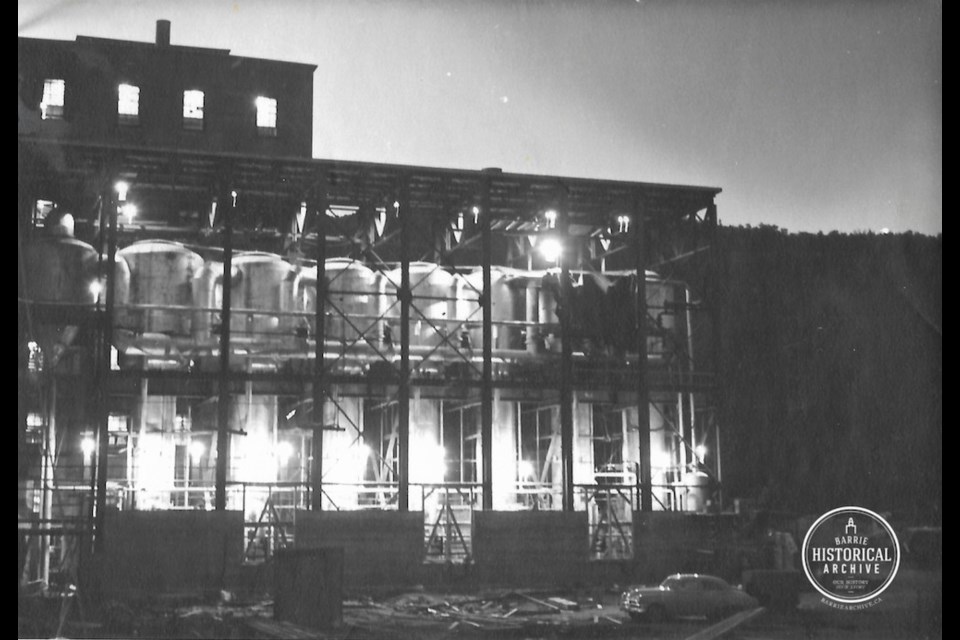Snow, Norfolk, Brockville Beauty, St. Lawrence and Duchess. These are apple varieties that you almost never hear of today, but there was a time when they were in very high demand in Barrie.
More than 100 years ago, only a few metres west of Bayfield Street, a rather busy processing plant was on a constant quest to acquire enough apples to keep their operation running.
Long gone is 122 Bayfield St., the former home of Abraham Rankin, an Irish-born contractor and woodworker who arrived in Barrie in 1867.
When Mr. Rankin retired in 1900, his business was taken over by Thomas Rogers. Rogers moved the business, then known as the Barrie Planing Mill, over to Sophia Street between Mary and Maple streets in 1904.
By 1907, J.W. Gossling, a cooper by trade, was advertising apple barrels for sale out of a rented space on Bradford Street, just across the road from the West Ward School, later known as Prince of Wales.
Gossling opened his own cooper shop in early 1908, on the corner of John Street (now Maple Avenue) and Sophia Street, next door to Thomas Rogers’ planning mill.
By mid August, Gossling was advertising that he had 2,000 apple barrels ready for sale at his new cooperage, just in time for harvest.
Soon J.W. Gossling made the leap from building the apple barrels to filling them. He partnered with James Vair, well-known local citizen of the Vairville Nursery clan and shop keeper in his own right, who was then fresh off his one-year term as Barrie mayor. They went into the apple business together.
The 1911 construction of a 54-by-56-foot apple processing factory on the same property as Gossling’s cooperage attracted quite a bit of attention.
The plan was to build a thoroughly modern facility to quickly dehydrate up to 80 barrels of fruit a day. Number 3 apples and fallen apples, normally unsuitable for sale, could be used in this process. Gossling expected to hire 20 local men.
The apples were peeled and cored mechanically, and then trimmed of blemishes by hand. They were bleached and then carried by conveyers to the second floor where they were sliced and kiln dried. The finished product was packed into 50-pound boxes made by J.W. Gossling.
Vair and Gossling made a serious go of this venture, spared no expense and insisted on the most modern of available technology. Passersby at the post office one Saturday morning formed a crowd around a strange looking implement and debated what it might be until a representative of the Bean Spray Pump Co., happily explained the ease at which a grower could douse his fruit trees with lead arsenate or lime sulphur with the device. A gas engine and an elevated pump platform made spraying for pests simple it was said.
The business did well for a time. From an initial investment of $2,500, the evaporator brought in $10,000 a year with most of that made in the three-month peak season. At their busiest, 100 barrels of apples a day were dealt with. From 100 pounds of raw apples, eight to 12 pounds of processed fruit could be produced.
With the making of barrels and boxes, the fruit processing and eventually cider pressing, and the addition of pesticide sales, Vair and Gossling were quite diversified.
Then something happened that could not have been foreseen: the Great War.
Much of Vair and Gossling’s dried fruit had been shipped to Holland while Germany imported peels and cores for wine production. All of that came to a sudden halt in 1914.
Men went away to war and gone were the labourers who trimmed and sprayed the orchards and picked the fruit. The Barrie apple factory could only gather one-third of the fruit that they required.
Even the cooperage was struggling. Apple barrels had once been sold at $2 a piece, but fetched less than half of that by mid-wartime.
After sitting idle for nearly a decade, the apple factory was torn down in 1922 and the construction materials were repurposed to build a house and a barn on a property owned by J.W. Gossling out in Vespra Township.
Gossling had reinvented himself once again and gone into the business of raising fox and mink for the fur industry.
Each week, the Barrie Historical Archive provides BarrieToday readers with a glimpse of the city’s past. This unique column features photos and stories from years gone by and is sure to appeal to the historian in each of us.



